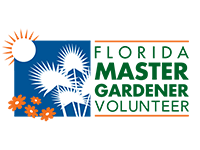The Neighborhood Gardener
How to be an Effective Lazy Gardener
By Lynn Barber, Hillsborough County Extension Florida-Friendly Landscaping™ Program
You, too, can have a beautiful garden while maintaining a "lazy gardener" lifestyle, by following these tips.
Lazy Gardener Tips
Right Plant/Right Place – Analyze sun, shade, water requirements, and soil composition before planting a single plant.
Lazy Watering – Hydrozone (which simply means grouping plants by water needs), use microirrigation, and harvest free water with a rain barrel or cistern.
Size – Determine garden dimensions, mature plant size, and laziest number of plants needed to fill space. Lazy gardeners do not plant for instant gratification but for mature plant size, because it saves time, work, and money.
Keep It Simple – If you are too lazy to water during dry spells, plant drought-resistant bloomers or wait until the rainy season. If you are too lazy to rake leaves or pine needles in the fall, create self-mulching landscape beds. If you are too lazy to plant annual flowers, plant perennials.
Sweat Savers – Repeat your successes and plant reseeders. Deadhead for more blooms and to save seeds. Use a "timer system": perform 15 minutes of a dreaded gardening activity, then stop when the timer goes off. You’ll be surprised what you can accomplish in 15 minutes!
Time Saver – Wear gloves (saves time cleaning your hands).
Maximize Your Laziness – Use your friends wisely and start a gardening group, learn to love "volunteer" plants (plants that are already growing in your landscape naturally) and permanently "borrow" plants from your friends and neighbors. Divide perennials: no need to shop, so no money spent, and you saved on gasoline. (Wait a minute—no shopping?!)
Lazy Maintenance Plants – Slow growers need less pruning. Wide spreaders means fewer plants. Drought-tolerant plants require less watering. Pest- and disease-resistant plants need less Lazy Pest Management.
"Low Demand and High Return" plants include: dracaena, plumbago, firecracker bush, African and walking iris, thryallis, pentas, firebush, croton, and salvia.
Lazy Gardening Limitations
Mulch – Takes a little work to put it down, but mulch saves a lot of time and effort in the long run. It regulates soil temperature, adds organic value, inhibits weeds, and retains soil moisture.
Fertilizing – Use slow release fertilizer every 3-4 months, per label. To be really lazy, don’t fertilize until you are sure of light rain for activation.
Pruning – Pruning achieves many things: it trains the plant to grow in a certain direction, improves health by removing diseased stems, and opens the interior for better air circulation. Pruning often encourages more flowers, more foliage, or bigger fruit. And of course, pruning restricts growth and keeps the plant within its boundaries. Deadheading (removing spent flowers) can reduce the need to prune.
War on Weeds – A weed is the wrong plant in the right place, the right plant in the wrong place, or a plant with nine lives. Using mulch (to a depth 2-3 inches after it settles) helps. If you choose to fight the weed war, you can cover weeds with newspapers to smother them, or point, aim, and shoot with an environmentally friendly weed killer spray.
Pests – Biting, sucking, and chewing! We have aphids, caterpillars, slugs, snails, scale, and spider mites. But remember: less than one-tenth of one percent are "bad bugs."
Lazy Pest Management (LPM) Alternatives – Murder by hand! Use two pinching fingers to squish pests, knock them off with a hard spray of water, or prune off infested sections. For more non-chemical solutions, read "Non-Chemical Solutions for Pests" on the Hillsborough County Extension website.
The Rewards of Laziness
Reading, golfing, sleeping, cooking, crafting—it's your choice!





